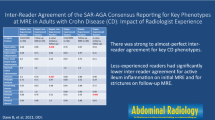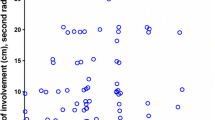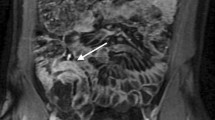Abstract
Purpose
To assess inter-radiologist agreement using the Society of Abdominal Radiology-American Gastroenterological Association (SAR-AGA) consensus recommendations for reporting CT/MR enterography exams in pediatric and young adult small bowel Crohn disease (CD).
Methods
Institutional review board approval was obtained for this HIPAA-compliant retrospective investigation; the requirement for informed consent was waived. 25 CT and 25 MR enterography exams performed in children and young adults (age range: 6–23 years) between January 2015 and April 2017 with a distribution of ileal CD severity (phenotype) were identified: normal or chronic CD without active inflammation (40%), active inflammatory CD (20%), stricturing CD (20%), and penetrating CD (20%). Five fellowship-trained pediatric radiologists, blinded to one another, documented key imaging findings and standardized impressions based on SAR-AGA consensus recommendations. Inter-radiologist agreement was evaluated using Fleiss’ multi-rater kappa statistic (κ) with 95% confidence intervals (CI).
Results
Inter-radiologist agreement was moderate for all key imaging findings except presence of ulcerations (κ 0.37 [95% CI 0.28–0.46]) and sacculations (κ 0.31 [95% CI 0.23–0.40]). Agreement for standardized impressions was substantial for stricturing disease (κ 0.79 [95% CI 0.70–0.87]) and moderate for presence of inflammation (κ 0.49 [95% CI 0.44–0.56]) and penetrating disease (κ 0.58 [95% CI 0.49–0.67]). No significant difference in agreement was found between CT and MRI.
Conclusions
Agreement among five pediatric radiologists was moderate to substantial for SAR-AGA standardized impressions and fair to moderate for key imaging findings of pediatric and young adult CD.


Similar content being viewed by others
References
Fletcher JG, Fidler JL, Bruining DH, Huprich JE (2011) New concepts in intestinal imaging for inflammatory bowel diseases. Gastroenterology 140(6):1795–1806. https://doi.org/10.1053/j.gastro.2011.02.013
Panes J, Bouhnik Y, Reinisch W, et al. (2013) Imaging techniques for assessment of inflammatory bowel disease: joint ECCO and ESGAR evidence-based consensus guidelines. J Crohns Colitis 7(7):556–585. https://doi.org/10.1016/j.crohns.2013.02.020
Towbin AJ, Sullivan J, Denson LA, Wallihan DB, Podberesky DJ (2013) CT and MR enterography in children and adolescents with inflammatory bowel disease. Radiographics 33(7):1843–1860. https://doi.org/10.1148/rg.337105140
Dillman JR, Trout AT, Smith EA (2016) MR enterography: how to deliver added value. Pediatr Radiol 46(6):829–837. https://doi.org/10.1007/s00247-016-3555-5
Mollard BJ, Smith EA, Dillman JR (2015) Pediatric MR enterography: technique and approach to interpretation-how we do it. Radiology 274(1):29–43. https://doi.org/10.1148/radiol.14122449
Orscheln ES, Dillman JR, Towbin AJ, Denson LA, Trout AT (2017) Penetrating Crohn disease: does it occur in the absence of stricturing disease? Abdom Radiol . https://doi.org/10.1007/s00261-017-1398-7
Bodily KD, Fletcher JG, Solem CA, et al. (2006) Crohn disease: mural attenuation and thickness at contrast-enhanced CT enterography–correlation with endoscopic and histologic findings of inflammation. Radiology 238(2):505–516. https://doi.org/10.1148/radiol.2382041159
Ordás I, Rimola J, Rodríguez S, et al. (2014) Accuracy of magnetic resonance enterography in assessing response to therapy and mucosal healing in patients with Crohn’s disease. Gastroenterology 146(2):374.e371–382.e371. https://doi.org/10.1053/j.gastro.2013.10.055
Bruining DH, Siddiki HA, Fletcher JG, et al. (2012) Benefit of computed tomography enterography in Crohn’s disease: effects on patient management and physician level of confidence. Inflamm Bowel Dis 18(2):219–225. https://doi.org/10.1002/ibd.21683
Higgins PD, Caoili E, Zimmermann M, et al. (2007) Computed tomographic enterography adds information to clinical management in small bowel Crohn’s disease. Inflamm Bowel Dis 13(3):262–268. https://doi.org/10.1002/ibd.20013
Deepak P, Fletcher JG, Fidler JL, et al. (2016) Radiological response is associated with better long-term outcomes and is a potential treatment target in patients with small bowel Crohn’s disease. Am J Gastroenterol 111(7):997–1006. https://doi.org/10.1038/ajg.2016.177
Bruining DH, Zimmermann EM, Loftus EV, et al. (2018) Consensus recommendations for evaluation, interpretation, and utilization of computed tomography and magnetic resonance enterography in patients with small bowel Crohn’s disease. Radiology 154(4):1172–1194. https://doi.org/10.1148/radiol.2018171737
Reiner BI, Knight N, Siegel EL (2007) Radiology reporting, past, present, and future: the radiologist’s perspective. J Am Coll Radiol 4(5):313–319. https://doi.org/10.1016/j.jacr.2007.01.015
Sistrom CL, Langlotz CP (2005) A framework for improving radiology reporting. J Am Coll Radiol 2(2):159–167. https://doi.org/10.1016/j.jacr.2004.06.015
Weiss DL, Langlotz CP (2008) Structured reporting: patient care enhancement or productivity nightmare? Radiology 249(3):739–747. https://doi.org/10.1148/radiol.2493080988
Larson DB, Towbin AJ, Pryor RM, Donnelly LF (2013) Improving consistency in radiology reporting through the use of department-wide standardized structured reporting. Radiology 267(1):240–250. https://doi.org/10.1148/radiol.12121502
RSNA (2009) RSNA radiology reporting initiative. http://reportingwiki.rsna.org/. Accessed 6 December 2017
Wildman-Tobriner B, Allen BC, Bashir MR, et al. (2017) Structured reporting of CT enterography for inflammatory bowel disease: effect on key feature reporting, accuracy across training levels, and subjective assessment of disease by referring physicians. Abdom Radiol . https://doi.org/10.1007/s00261-017-1136-1
Wildman-Tobriner B, Allen BC, Davis JT, et al. (2017) Structured reporting of magnetic resonance enterography for pediatric Crohn’s disease: effect on key feature reporting and subjective assessment of disease by referring physicians. Curr Probl Diagn Radiol 46(2):110–114. https://doi.org/10.1067/j.cpradiol.2016.12.001
Hawkins CM, Hall S, Hardin J, Salisbury S, Towbin AJ (2012) Prepopulated radiology report templates: a prospective analysis of error rate and turnaround time. J Digit Imaging 25(4):504–511. https://doi.org/10.1007/s10278-012-9455-9
Hawkins CM, Hall S, Zhang B, Towbin AJ (2014) Creation and implementation of department-wide structured reports: an analysis of the impact on error rate in radiology reports. J Digit Imaging 27(5):581–587. https://doi.org/10.1007/s10278-014-9699-7
Schwartz LH, Panicek DM, Berk AR, Li Y, Hricak H (2011) Improving communication of diagnostic radiology findings through structured reporting. Radiology 260(1):174–181. https://doi.org/10.1148/radiol.11101913
Harris PA, Taylor R, Thielke R, et al. (2009) Research electronic data capture (REDCap): a metadata-driven methodology and workflow process for providing translational research informatics support. J Biomed Inform 42(2):377–381. https://doi.org/10.1016/j.jbi.2008.08.010
Landis JR, Koch GG (1977) The measurement of observer agreement for categorical data. Biometrics 33(1):159–174
Gale HI, Sharatz SM, Taphey M, et al. (2017) Comparison of CT enterography and MR enterography imaging features of active Crohn disease in children and adolescents. Pediatr Radiol 47(10):1321–1328. https://doi.org/10.1007/s00247-017-3876-z
Church PC, Greer MC, Cytter-Kuint R, et al. (2017) Magnetic resonance enterography has good inter-rater agreement and diagnostic accuracy for detecting inflammation in pediatric Crohn disease. Pediatr Radiol 47(5):565–575. https://doi.org/10.1007/s00247-017-3790-4
Booya F, Fletcher JG, Huprich JE, et al. (2006) Active Crohn disease: CT findings and interobserver agreement for enteric phase CT enterography. Radiology 241(3):787–795. https://doi.org/10.1148/radiol.2413051444
Wallihan DB, Podberesky DJ, Sullivan J, et al. (2015) Diagnostic performance and dose comparison of filtered back projection and adaptive iterative dose reduction three-dimensional CT enterography in children and young adults. Radiology 276(1):233–242. https://doi.org/10.1148/radiol.14140468
Wallihan DB, Towbin AJ, Denson LA, Salisbury S, Podberesky DJ (2012) Inflammatory bowel disease in children and adolescents: assessing the diagnostic performance and interreader agreement of magnetic resonance enterography compared to histopathology. Acad Radiol 19(7):819–826. https://doi.org/10.1016/j.acra.2012.02.023
Tielbeek JA, Makanyanga JC, Bipat S, et al. (2013) Grading Crohn disease activity with MRI: interobserver variability of MRI features, MRI scoring of severity, and correlation with Crohn disease endoscopic index of severity. AJR Am J Roentgenol 201(6):1220–1228. https://doi.org/10.2214/AJR.12.10341
Tielbeek JA, Bipat S, Boellaard TN, Nio CY, Stoker J (2014) Training readers to improve their accuracy in grading Crohn’s disease activity on MRI. Eur Radiol 24(5):1059–1067. https://doi.org/10.1007/s00330-014-3111-3
Puylaert CA, Tielbeek JA, Bipat S, et al. (2016) Long-term performance of readers trained in grading Crohn disease activity using MRI. Acad Radiol 23(12):1539–1544. https://doi.org/10.1016/j.acra.2016.08.006
Author information
Authors and Affiliations
Corresponding author
Ethics declarations
Funding
This study was not funded.
Conflict of interest
The authors declare that they have no conflict of interest.
Ethical approval
This article does not contain any studies with human participants performed by any of the authors.
Informed consent
The requirement for informed consent was waived by the institutional review board.
Electronic supplementary material
Below is the link to the electronic supplementary material.
Rights and permissions
About this article
Cite this article
Rees, M.A., Dillman, J.R., Anton, C.G. et al. Inter-radiologist agreement using Society of Abdominal Radiology-American Gastroenterological Association (SAR-AGA) consensus nomenclature for reporting CT and MR enterography in children and young adults with small bowel Crohn disease. Abdom Radiol 44, 391–397 (2019). https://doi.org/10.1007/s00261-018-1743-5
Published:
Issue Date:
DOI: https://doi.org/10.1007/s00261-018-1743-5




